The vibrations of the tire and wheel assembly are the next level of testing for low frequency vibrations that are sensitive to vehicle speed. Systematically test the following items according to the symptoms:
| • | The tires |
| • | The wheels |
| • | The brake rotors |
| • | The wheel hubs |
First-Order Tire and Wheel Assembly Vibration
The tire and wheel assemblies cause the following symptoms of first-order vibrations:
| • | The vibration is always related to the speed of the vehicle. |
| If the speed of the engine affects the vibration, or shifting the transmission into Neutral eliminates the vibration, the tire and wheel assemblies do not affect the vibration. |
| • | The vibration will feel like a shake, usually in the steering wheel or in the seat. |
| - | The vibrations that are felt in the steering wheel are probably related to the front tire and wheel assemblies. |
| - | Vibrations that are felt in the seat or in the floor are probably related to the rear tire and wheel assemblies. |
| - | The previous guidelines may not apply to every condition, but these guidelines may aid in isolating a condition to the front or to the rear of the vehicle. |
| • | The vehicle "waddles" at low speeds of 8-56 km/h (5-35 mph). |
| • | The frequency on the electronic vibration analyzer will correspond to the first-order of tire rotation. Usually, this frequency will be in the 10-20 hertz range, depending on the speed of the concern and on the size of the tire. A smaller tire will rotate faster at any speed |
| • | The human ear begins to hear at 20 hertz. For this reason, first-order tire vibrations infrequently produce noise. The exception is when the tires display an irregular tread pattern or flat spots. Tires with irregular tread patterns or flat spots can cause a growling noise or a slapping noise. |
Tire Runout Measurement
First, correct the runout concern, because the runout of a tire and wheel assembly will directly affect the amount of imbalance and radial force variation. As the amount of runout decreases, the imbalance and the force variation also decrease.
Important: Before measuring excessive runout or attempting to correct excessive runout, carefully inspect the tire for an uneven bead seat. The distance from the edge of the ring to the concentric rim locating ring should be equal around the entire circumference. If the beads do not seat correctly, mount the tire again. Otherwise, excessive runout and an imbalance may result.
You can correct the radial runout and the lateral runout at the same time. Two methods are available for measuring runout of the tire and wheel assemblies:
| • | With the tire on the vehicle, mount the tire to the hub. The wheel bearing must be in good condition. |
| • | With the tire off the vehicle, mount the tire on a tire balancer. |
After making an initial on-car inspection, perform the off-car runout tests.
Measuring the runout of the tire and wheel assembly off the vehicle is the easier method for the following reasons:
| • | A dial indicator can be more easily mounted in the correct location. |
| • | A decreased chance of water, of snow, of dirt, or of slush getting on the dial indicator. A dial indicator is a very fragile tool and an expensive tool that is used extensively in vibration repair work. Usually, contamination of the dial indicator by the elements or by rough handling will result in malfunction. |
Measure the runout off the vehicle. Correct the runout off the vehicle. A quick inspection of runout on the vehicle will indicate if further conditions exist.
If the off-vehicle measurement differs significantly from the on-vehicle measurement, the runout condition is because of one of the following conditions:
| • | Stud circle runout |
| • | Hub flange runout |
| • | A mounting problem between the wheel and the vehicle. Refer to Wheel Hub/Axle Flange Runout, and Wheel Stud (Stud Circle) Runout procedures. |
Measuring Tire Runout
If a vehicle sits in one place for an extended period, flat spots may develop at the point where the tires rest upon the ground. These flat spots will affect the runout readings. Before you take runout measurements, eliminate these flat spots by driving the vehicle long enough to warm up the tires.
- Lift the vehicle on a hoist, or support the vehicle with jack stands. Refer to Lifting and Jacking the Vehicle in General Information.
- Spin all of the tire and wheel assemblies on the vehicle by hand. Perform this action in order to get an initial indication of existing runout . You may also use the engine at a slow speed in order to drive the wheels. Inspect the amount of runout from the front or from the rear.
- Mark the location of each tire and wheel assembly in relation to the wheel studs and to wheel stud's position on the vehicle for future reference.
- Remove the tire and wheel assemblies one at a time. Mount each assembly on a wheel balancer. Locate the tire and wheel assembly on the balancer with a cone through the back side of the center pilot hole.
- For lateral runout, place the dial indicator in a smooth area on the tire sidewall, as close to the tread as possible.
- Measure the runout of the tire and wheel assembly as shown in the figure.
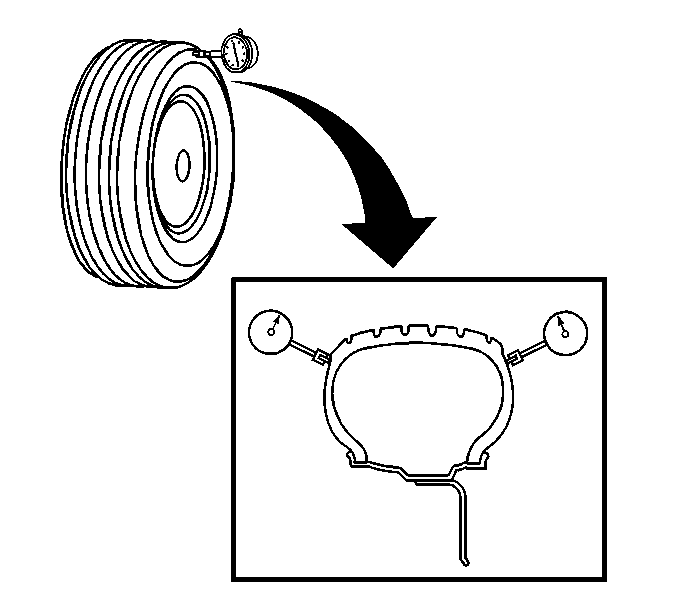
Radial Tire Runout

When measuring the radial runout, wrap the outer circumference with some tape (1). This allows for a smooth reading from the dial indicator.
Ignore bumps or dips because of sidewall splices.
Use either of the following dial indicator sets with roller contact point J 23672 when applying this procedure:
| • | J 8001 with a clamp-on base |
| • | J 7872 with a magnetic base |
- Load the indicator and slowly rotate the assembly 1 complete revolution.
- Set the indicator to zero on the low spot.
- Rotate the assembly completely. Note the total amount of runout. The following measurements show the maximum assembly radial runout and lateral runout that is allowed:
| • | 0.050 inch when measured off the vehicle |
| • | 0.060 inch when measured on the vehicle |
Vectoring (Match Mounting)
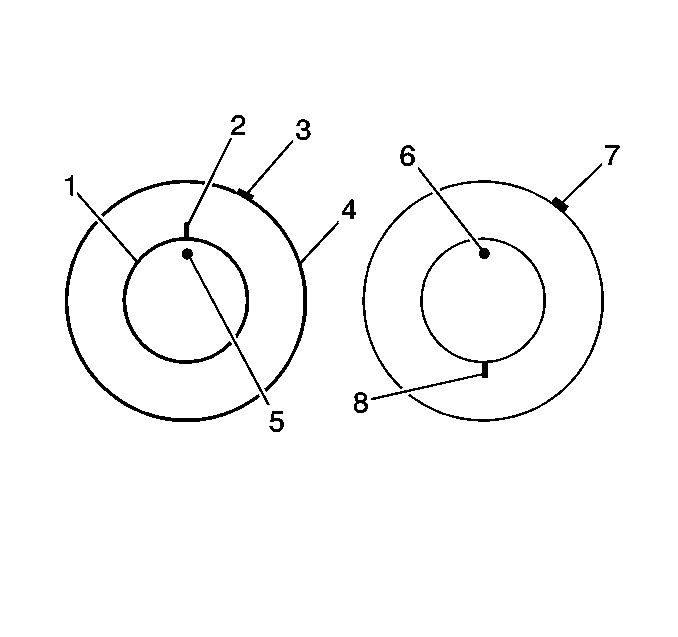
If the runout is excessive, mark the location of the high spot (3) and the low spot on the tire.
Next, determine if the runout condition exists in the tire, in the wheel, or in a combination of the tire and of the wheel. Correct the condition. This procedure, called match-mounting or vectoring, uses the following steps:
- Place a mark (2) on the tire side-wall at the location of the valve stem (5). This mark is the 12 o'clock position. Always refer to the location of the high spot (3) in relation to the high spot's clock position on the wheel.
- Mount the tire and wheel assembly on a tire machine, and break down the bead. Do not remove the tire from the wheel at this time.
- Rotate the tire 180 degrees on the rim. Verify that the valve stem reference mark (8) is at 6 o'clock in relation to the valve stem (6). You may need to lubricate the bead in order to easily rotate the tire on the wheel.
- Inflate the tire again, and seat the bead correctly.
- Mount the assembly on the tire balancer, and measure the runout again. Mark the new location of the runout high point on the tire.
- If runout is now within tolerance, do not continue the procedure. Balance and mount the tire on the vehicle. Refer to Tire and Wheel Balancing .
Important: After replacing a tire or a wheel, measure the runout of the tire and wheel assembly again, in order to verify that the runout is within tolerance.
| • | If the clock location of the high spot remained near the clock location of the original high spot (7), the wheel is the major cause of the runout condition. Refer to Wheel Runout Measurement. |
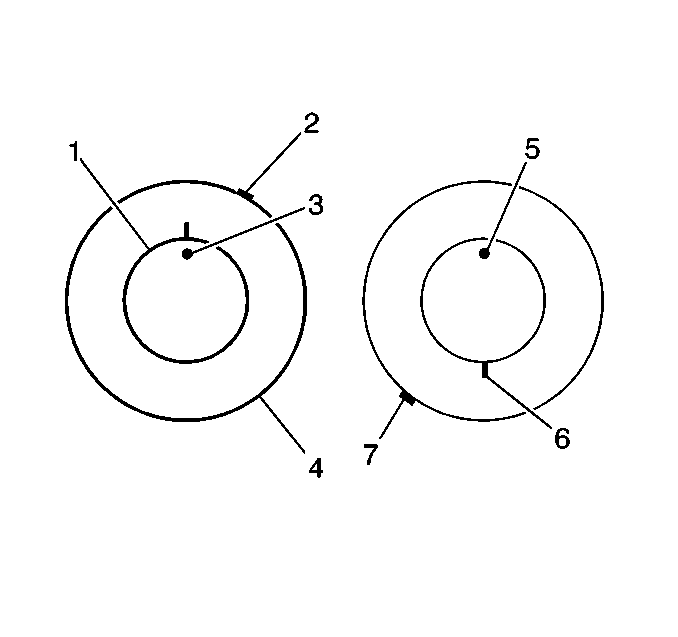
| • | If the high spot (7) is now near a position that is 180 degrees (6 hours) from the original high spot, the tire is the major cause of the runout condition. |
| • | Replace the tire. |
| • | If the high spot is located between the two extreme positions, then the tire and the wheel are contributing to the runout. Rotate the tire clockwise and counterclockwise an additional 90 degrees (3 hours). |
Wheel Runout Measurement
Lateral Wheel Runout
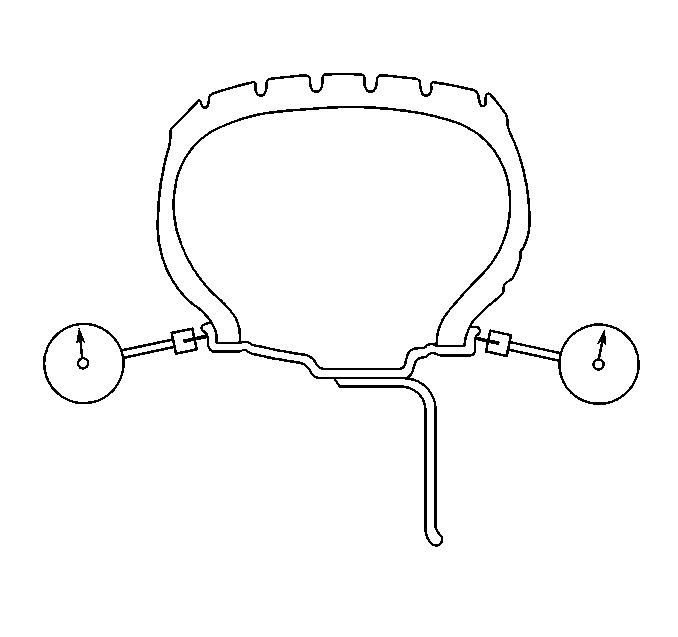
Complete the following steps if you cannot bring runout within tolerance by match-mounting:
- Remove the tire from the wheel.
- Measure the lateral wheel runout.
Radial Wheel Runout
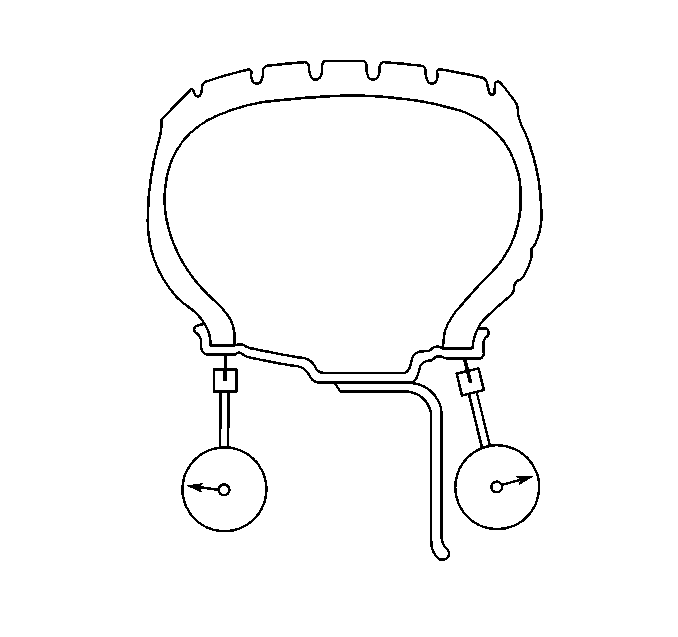
Complete the following steps if you cannot bring runout within tolerance by match-mounting:
- Remove the tire from the wheel.
- Measure the radial wheel runout.
Lateral Wheel Runout (Tire Removed)
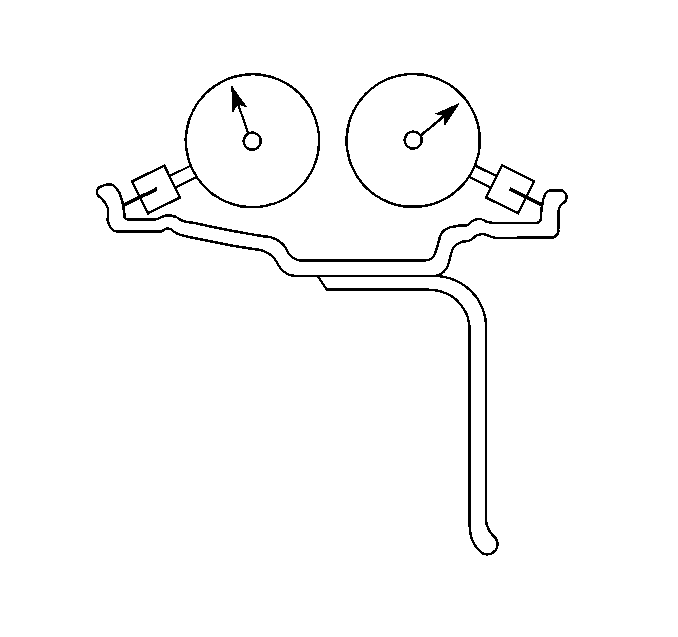
You can measure rim runout more accurately on the inside bead area of the wheel. Measure wheel runout using the same procedure as the tire runout procedure. Ignore the jumps or the dips that are caused by the paint drips, by the chips, or by the welds.
Radial Wheel Runout (Tire Removed)
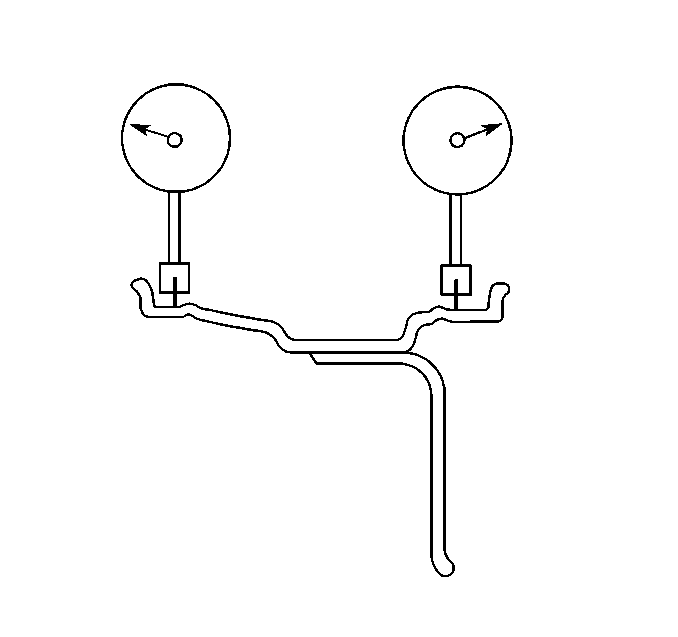
Measure the inboard flange and the outboard flange as shown. The tolerances for wheel runout are as follows:
| • | Steel Wheels: |
| - | Radial runout-0.040 in |
| - | Lateral runout-0.045 in |
| • | Aluminum Wheels: |
| - | Radial runout-0.030 in |
| - | Lateral runout-0.030 in |
If the runout of the wheel is beyond the tolerance, replace the wheel.
Important: Always measure the runout of new wheels. Do not assume that a new wheel is automatically good.
When replacing a wheel, refer to the wheel code that is stamped next to the valve stem. Compare the letter code with the parts book.
If the runout of the wheel is within tolerance, and the runout of the tire and wheel assembly cannot be reduced to an acceptable level by using the match-mounting technique, replace the tire.
Important: After you replace the tire, always measure runout of the tire and wheel assembly again.
If you notice a large difference in runout measurements between on-vehicle testing and off-vehicle testing, the runout condition is caused by one of the following:
| • | Stud circle runout |
| • | Hub flange runout |
| • | A mounting problem between the wheel and the vehicle |
The listed tolerances should serve only as a guideline. If runout measurements are within tolerance but are marginal, some sensitive vehicles may still be affected. Always reduce runout to as little as possible in order to attain optimum results under all conditions.
Radial Force Variation
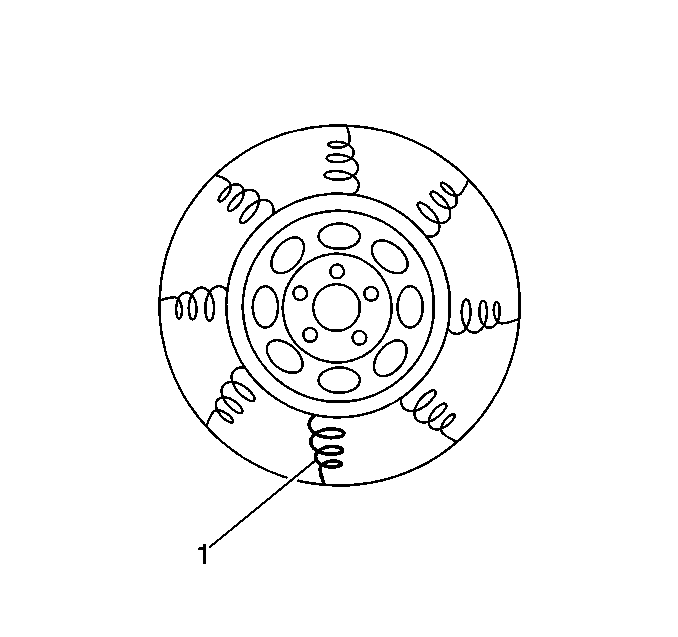
Radial force variation is the difference in the stiffness of a tire (1) as the tire rotates and contacts the road. The tire and wheel assemblies have some variation that is caused by splices in the tire plies. These splices do not cause a problem unless the force variation is excessive. These stiff spots in the tire can deflect the tire and wheel assembly upward as the assembly contacts the road.
If the tire has only one stiff spot, the spot will deflect the spindle one time per revolution of the tire and wheel assembly. This causes a first-order wheel vibration. If the tire has two stiff spots, the spots cause a second-order vibration. The following conditions are the most common wheel vibrations. This is attributed to radial force variation.
| • | First-order tire and wheel vibrations |
| • | Second-order tire and wheel vibrations |
Third-order wheel vibration, fourth-order wheel vibration, or higher wheel vibrations are possible but do not often occur.
Ensure that the tire and wheel assembly runout is at an absolute minimum. This is the best way to minimize the possibility of force variation as a factor in the vibrations of the tire and wheel assembly. However, some tire and wheel assemblies have force variation that causes a vibration although the assemblies are within runout tolerances and within balance tolerances. These instances are becoming increasingly rare because of tighter tolerances and higher standards in manufacturing.
If you suspect that force variation is a factor in the cause of the vibration of the tire and wheel assembly, replace the poor assembly with a known good assembly .
You may buff the tires on a tire matching machine in order to eliminate spindle deflection. This type of equipment removes small amounts of rubber from the outer rows of the tread blocks at the location of the stiff spots under load. This equipment is not currently used in all places. Do not use a tool that is designed in order to make the tire perfectly round. These tools will not correct the condition.
You may substitute one or more known good tire and wheel assemblies when a local tire manufacturer is not available.
Lateral Force Variation
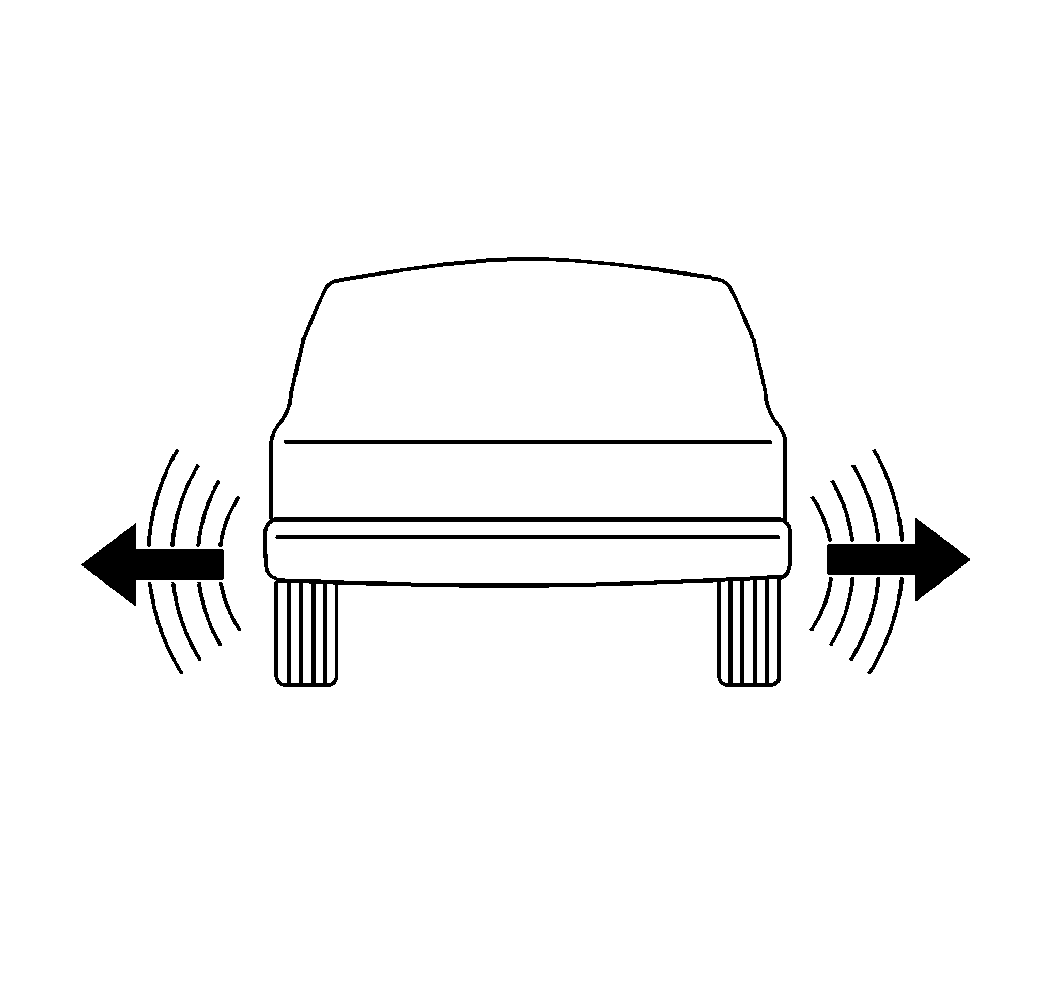
Lateral force variation tends to deflect the vehicle to the side. Lateral force variation is based on the same concept as radial force variation. A belt inside the tire may be the cause of lateral force. Before installing replacement tires, test the vehicle with substitute tires.
A lateral force variation condition is not common. Minimize the lateral runout of the tire and wheel assembly in order to eliminate lateral force variation.
The vehicle will wobble or waddle at slow speeds of 8-40 km/h (5-25 mph) when lateral force variation is excessive. Usually, this condition is related to the first-order of the tire and the wheel rotation.
Wheel Hub/Axle Flange Runout
When lateral runout occurs, inspect the wheel hub and/or the axle flange runout if you are performing an on-vehicle test procedure, but not during off-vehicle testing. The tolerances that are provided are only guidelines. Perform corrections only if the on-vehicle runout cannot be brought to within tolerance.
- Position the dial indicator on the machined surface of the hub, of the axle flange, or of the rotor on the outside of the wheel studs.
- Rotate the hub in order to find the low spot.
- Set the dial indicator to zero at the low spot.
- Rotate the hub again, and check the total amount of runout.
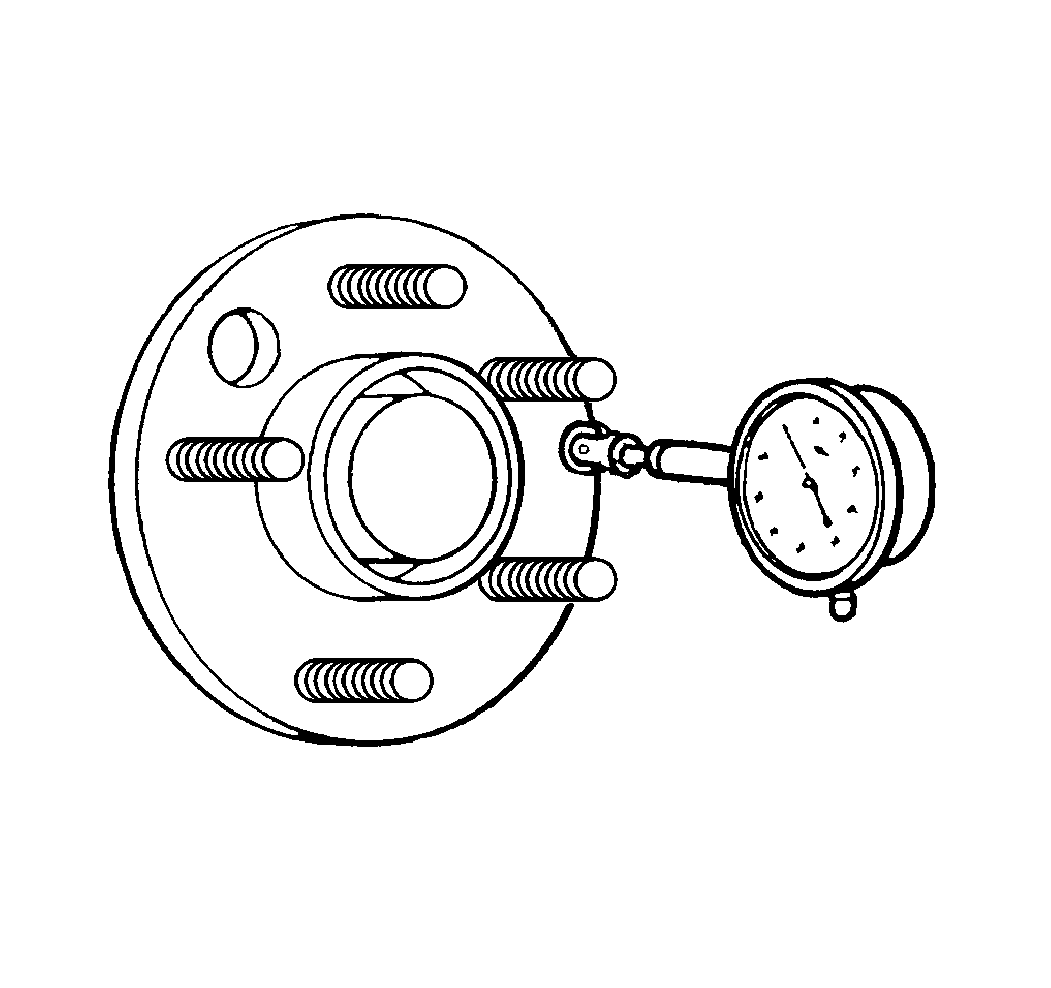
Specification
Runout tolerance: 0.130 mm (0.0050 in)
Wheel Stud (Stud Circle) Runout
Use the wheel stud runout procedure when the following conditions occur:
| • | The off-vehicle radial runout differs significantly from the on-vehicle radial runout. |
| • | Earlier attempts to correct the vibration of the tire and of the wheel have not been successful |
- Position the dial indicator in order to contact the wheel mounting studs.
- Zero the dial indicator on the lowest stud.
- Rotate the hub again, and check the total amount of runout.
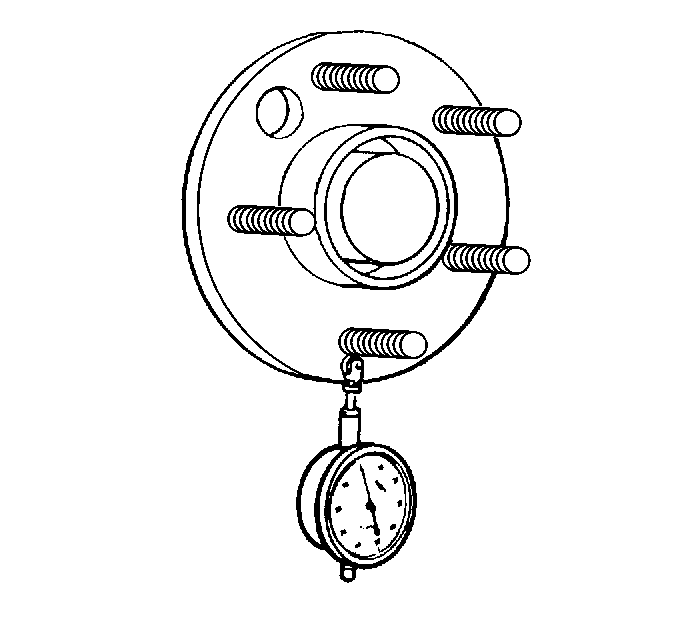
Measure the stud runout as close to the flange as possible.
Turn the hub in order to register on each of the studs.
Specification
Runout tolerance: 0.80 mm (0.030 in)
